Han Dynasty › Akrotiri Frescoes » Origins and History
Articles and Definitions › Contents
- Han Dynasty › Ancient History
- Akrotiri Frescoes › Antique Origins
Ancient civilizations › Historical places, and their characters
Han Dynasty › Ancient History
Definition and Origins

The Han Dynasty (206 BCE-220 CE) was one of the longest of China ’s major dynasties. In terms of power and prestige, the Han Dynasty in the East rivalled its almost contemporary Roman Empire in the West. With only minor interruptions it lasted a span of over four centuries and was considered a golden age in Chinese history especially in arts, politics and technology. All subsequent Chinese dynasties looked back to the Han period as an inspiring model of a united empire and self-perpetuating government.
THE ORIGINS OF THE HAN DYNASTY
In 202 BCE, Emperor Gaozu, whose given name was Liu Bang, became the first Han emperor after defeating the last rebellion against him. He had already been king of Han since 206 BCE (the formal beginning of the Han dynasty). During the previous dynasty, the Qin, Liu Bang had been a minor official. The Qin dynasty (221-206 BCE) was very short and cruel; by the time it collapsed, Liu Bang had raised an army and claimed the vacant throne. He was not the only one in the quest for power, and one of his most important opponents was a general named Xiang Yu (also known as Xiang Ji). We are told that Xiang Yu captured Liu Bang's father and sent a final warning to Liu Bang, assuring that his father would be boiled alive unless Liu Bang surrendered. Liu Bang's answer suggests that he did not get along very well with his father: “Send me a cup of the soup”, he replied. In the end, Liu Bang's father was not turned into soup, and Xiang Yu decided to end his own life by committing suicide in 202 BCE. Some accounts say he was defeated in battle, while others tells us he was never defeated in battle but was gradually undermined by the popular support for Liu Bang; Liu Bang was the first Chinese emperor who was originally a commoner.
Liu Bang established the imperial capital in the city of Chang'an, located 3 km northwest of modern Xi'an, which was chosen due to its strategic importance: it not only had a central position (all major roads converged in Chang'an), but it would also become the eastern end of the Silk Road. The city turned into the political, economic, military, and cultural centre of China and by 2 CE its population was nearly 250,000. In 195 BCE, upon Liu Bang's death, his empress Lü Zhi (also known as Lü Hou) tried to confiscate the empire for her own family. Her methods show a firm determination: she murdered several of Liu Bang's sons born to concubines, mutilated his favourite mistress and had her thrown into a latrine. She also replaced with her own relatives many of the loyal generals and members of Liu Bang's family who ruled the fiefdoms. The conflict lasted for 15 years, until finally the Liu Bang clan regained control of the empire: Emperor Wen, a surviving Liu Bang son, was finally enthroned re-establishing the broken lineage. The imperial wrath was ruthless: the Lius killed every single member of Lü Zhi's clan they managed to find.
ACHIEVEMENTS DURING THE HAN DYNASTY
During Han times, pulleys and wheelbarrows were used to move goods. To pulverize ores and grains, they employed the water-powered trip-hammer and air was pumped into furnaces thanks to the aid of bellows.
THE OPENING OF THE SILK ROAD WAS PROBABLY THE MAJOR ECONOMIC ACHIEVEMENT OF THE HAN DYNASTY.
It was a eunuch named Cai Lun who, around 105 CE, came up with an innovation that would be invaluable for learning. A screen was dipped into a vat of watery oatmeal-like pulp made of rice straw and inner tree bark. When the screen was raised, it had a layer of dripping slush on top, which was later pressed and dried. The end result was a sheet of paper. However, during Han times, paper was used largely to wrap fish rather than for written documents. Just a few written paper sheets survived to our days from Han times, mostly found in tombs. Tens of thousands of written documents have come down to our day, most of them on wooden tablets and slips of bamboo. Examples include mathematical problems, historical records, poetry, government records, a massive dictionary, and the oldest surviving large-scale census of all history, which reports 57,671,400 people in 2 CE. All these documents have been critical in our fairly good historical knowledge of the Han dynasty.
The largest Chinese historiographic work, known as the “Records of the Grand Historian”, was written during the Han Dynasty by Sima Qian, who is referred to as the father of Chinese historiography. This work is a vast general history of China which covers a period of over 2,000 years, from the mythical times of the Yellow Emperor (the founder of the first Chinese dynasty, the Xia) to his own time during the reign of Emperor Wu (also known as Wu Di) who reigned between 141 and 87 BCE.
The opening of the Silk Road was probably the major economic achievement of the Han Dynasty. Emperor Wu took the initiative to set out on diplomatic missions to various rulers in Central Asia. This led to the exploration of trade routes that linked Xi'an to the Levant coast on the Mediterranean and opened up new roads for merchants. This increased the trade and economic prosperity of the empire and also led to a constant cultural exchange between several cultures.
It was also during Wu Di's time that China incorporated the whole of modern China proper, northern Vietnam, Inner Mongolia, southern Manchuria, and most of Korea.

Map of the Eastern Hemisphere (1 CE)
THE SACK OF CHAN'GAN
Wang Man was a government official and a member of a powerful family who took control of the empire by usurping the throne and proclaiming the the beginning of a new dynasty called Xin, or “new”, in 9 CE. He took advantage of the fact that since the time Emperor Wu died in 87 BCE, the Han Dynasty had been immersed in various political and social conflicts. The gap between rich and poor was already a serious problem. Sima Qian reports about this period that exploiters “were busy accumulating wealth and forcing the poor into their hire”. The court was also affected by complicated political turmoil: endless accusations, executions, treason, and battles were weakening the government.
Wang Man wanted to re-establish the social order by changing the land owning structure: he decreed that those large estates which had been favoured in the past (and threatened imperial power), be dissolved and their lands distributed among peasants, an initiative firmly opposed by the aristocracy. The 14 years of unsuccessful attempts to amend the unfair landownership pattern, coupled with a terrible flooding of the Yellow River, set the stage for Wang Man's end: a full-scale peasant rebellion was triggered. The angry mobs of hungry peasant insurgents had their own identity badge: red paint smeared on their foreheads. The rebels thus were known as the “Red Eyebrows”. Wang Man tried to restore order, but late in 23 CE the Red Eyebrows entered Chang'an, sacked it, and cut off Wang Man's head. Liu Xiu, a ninth-generation descendant of Liu Bang, took back control of the empire thus re-establishing the Han lineage. Liu Xiu led his loyal officials to the city of Luoyang, where the imperial capital was relocated after the disaster of Chang'an.
The Han reign in Chang'an is usually referred to as Western Han or Former Han, while the period in Luoyang is normally called Eastern Han or Later Han.

A Chinese Servant Statue
THE LAST DAYS OF THE HAN DYNASTY
By the end of the 1st century CE, one Han emperor after another had died either young or without a chosen heir. When an emperor died without sons, a close relative, such as his cousin, was named emperor. In some cases the new ruler was a child or even an infant, in which case the real power was in the hands of a guardian from the family of the empress, since even infant rulers had to have an empress. This scenario led to all types of cunning schemes in the court.
A number of different natural calamities such as tremors, floods, and grasshopper plagues took place during these days and were seen as manifestations of the anger of heaven; prognosticators concluded that the end of the dynasty was close. The situation finally ran out of control. Eunuchs turned into an influential group in the bloody political court conflicts, gaining power and enriching themselves and there was a big protest of thousands of members of the Confucian academy against the corruption of the government. In 184 CE a very large peasant uprising known as the Yellow Turban Rebellion (sometimes referred to as the Yellow Scarves Rebellion) threatened the imperial capital.
A warlord named Dong Zhou seized control of the imperial capital in 190 CE and placed a child, Liu Xie, as the new ruler. Liu Xie was also a member of the Han family, but real power was in the hands of Dong Zhou. Dong Zhou killed all the eunuchs and burned Luoyang to the ground. Battle after battle weakened the imperial order until Liu Xie finally abdicated in 220 CE, the last year of the Han period. Wars between warlords and states continued and China would have to wait around 350 years to be unified again.
THE LEGACY OF THE HAN DYNASTY
The Han Dynasty has influenced the East just like Greece or Rome has influenced the West. The biggest Chinese historiographic work of antiquity was written during this period. Chinese calligraphy developed into an art. Confucianismwas made the official state ideology during the time of Emperor Wu Di, who built an academy solely devoted to the works of Confucius. The philosopher had long been dead, but his disciples managed to preserve his teachings. Confucianism, favoured by the patronage of the state, gained a strength similar to Buddhism during the time of Emperor Ashoka or Christianity after Constantine. Thousands of Confucian academies were built, spreading Confucian ethics across China and most of East Asia and would dominate Chinese ethics during the centuries to come. Even today, the ethnic Chinese refer to themselves as Han rem (Han people). Although history tells us, then, that the Han Dynasty ended in 220 CE, from the examples cited above it is clear that the Han still lives on today in many different forms.
Akrotiri Frescoes › Antique Origins
Ancient Civilizations
The Bronze Age frescoes from Akrotiri on the Aegean island of Thera (modern-day Santorini) provide some of the most famous images from the ancient Greek world. Sometime between 1650 and 1550 BCE Thera suffered a devastating earthquake which destroyed the town, and this catastrophe was soon followed by a volcanic eruption which covered the settlement of Akrotiri in metres-thick layers of pumice and volcanic ash. As a result, the vibrant frescoes which were on the walls of almost all buildings in the town have been remarkably well preserved. When the first systematic excavations began in 1967 CE, the secrets and wonders of this lost ancient city were finally re-discovered and once again admired by the human eye.
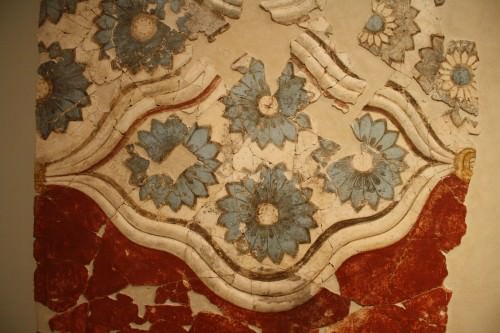
Wall-Painting, Akrotiri
METHOD & MATERIALS
The vast majority of frescoes belonged to the second story of buildings, and their presence in buildings of all types suggests that frescoes were not restricted to a rich elite but were enjoyed by all classes of society. The interior walls were covered with a layer of smooth lime plaster and then painted, either when the plaster was fresh ( fresco ) or dry ( secco or tempera ). Some of the geometric designs, especially spirals, show signs of mechanical devices to achieve greater accuracy. Similarly, in order to portray people accurately, figures employed a grid system which was proportionally adjusted depending on the age or dimension of the figure. Paints were derived from minerals to provide strong colours such as red, orange, black, blue, purple, and white, and organic material was used as a fixative.
SUBJECTS
In many cases all four walls were decorated to create a panoramic scene which sometimes transports the viewer out of the confines of the room. From 2000 BCE until the fateful earthquake and eruption, Thera had established itself as a thriving Mediterranean trading centre with links to the peoples of Crete, the Cyclades, mainland Greece, and Egypt, and this is reflected in the subject of some of the frescoes and in their style which displays many similarities to frescoes on Minoan Crete and in Egypt.
THE FRESCOES DISPLAY A CLEAR LOVE OF THE SEA & THE NATURAL WORLD WITH SEASCAPES, ANIMALS, FISH, & PLANTS BEING POPULAR SUBJECTS.
The frescoes display a clear love of the sea and the natural world with seascapes, animals, fish, and plants being popular subjects. There are naturalistic representations of bulls, goats, antelopes, monkeys, wild-cats, ducks, and swallows, and there are also mythological creatures, notably griffins. Geometrical and abstract shapes, especially curves and spirals, were also a common theme as are scenes of everyday life such as religious ceremonies and the collecting of crocuses and saffron. These latter scenes are also invaluable for historians to note such items as Bronze Age clothes, jewellery, hairstyles, armour, weapons, architecture, landscapes, and crafts such as ship-building.
Dr. N. Marinatos summarises the purpose of frescoes at Akrotiri as much more than works of mere aesthetic value; she convincingly argues that the frescoes had a specific connection to the function of the room in which they were painted:
For a Minoan or Theran, a painting represented part of his tradition which was comprehensible and even predictable. It can be said that art was a representation of the collective values of the society of which the viewer was a member. Thus, the relationship between art and viewer was intimate and the function of the painting important...the themes centred around religious experiences, although these could be indirect as well as direct.Political portraiture seems to be totally absent. (33)
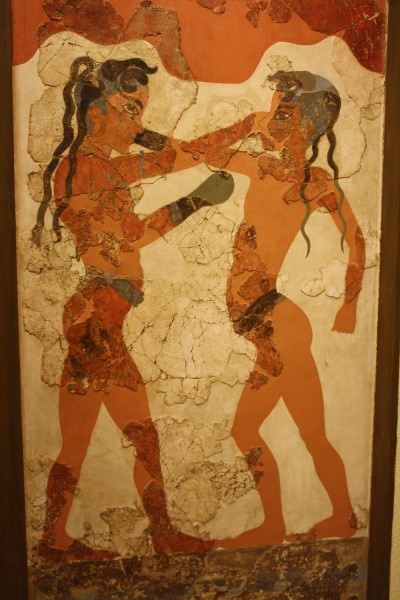
Boxers Fresco, Akrotiri, Thera
THE BOXERS FRESCO
This fresco comes from Room B1 of Building Beta and depicts two youths boxing, perhaps a ritual sport rather than a competitive match. The other three walls of this room have a much larger fresco depicting antelopes. That the boxers are boys is suggested by the red colouring, a typical convention when showing males. They wear only a belt and loincloth with a boxing glove only on the right hand. Their hair has long tresses with shaved parts - a sign of youth. The boy on the left wears a surprising amount of jewellery: necklace, earrings, bracelets, and anklets, whilst his opponent has none. Marinatos suggests that the playful competition of strength mirrors the competing antelopes who also seem to be facing off on the other walls of the room. (National Archaeological Museum, Athens ).
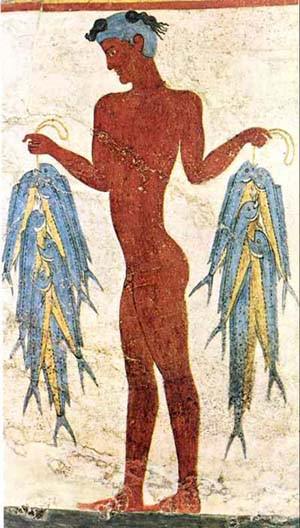
Fisherman Fresco, Akrotiri
THE FISHERMAN FRESCO
This fresco is from the north-eastern corner of Room 5 in the West House. It is one of the best preserved frescoes from Akrotiri and shows a male figure holding a bunch of fish in each hand tied together with yellow string. A very similar fresco adorned the adjoining wall. Both figures are nude and have partially shaved heads; both points strongly suggest these figures are youths performing a religious ritual. This religious connection is reinforced by the presence of recesses in the walls of Room 5 and ritual pottery vessels in the adjoining corridor. Even more convincing evidence that the figures are giving an offering of fish is that both figures are walking in the direction of the north-west corner of the room precisely where an offering table was found by archaeologists. (National Archaeological Museum, Athens).
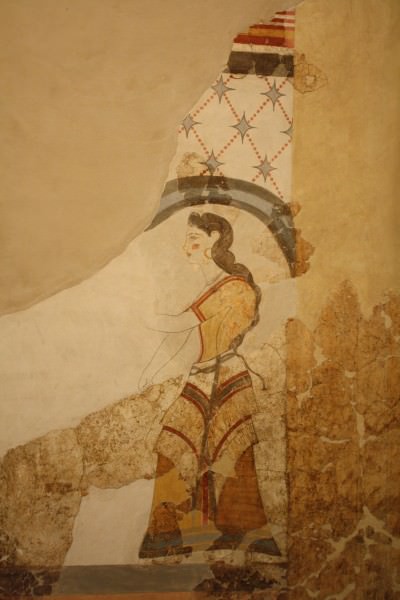
Fresco from the House of the Ladies, Akrotiri
THE LADIES FRESCO
This fresco is in fact two separate pieces, each depicting a woman, and they come from Room 2 of the House of the Ladies and were positioned in the other half of the room in which there was also the Papyrus Fresco (see below). The women are wearing coloured Minoan robes with kilts and jackets which leaves the breasts exposed in typical Minoan fashion. The women each wear earrings and a necklace and they both have long hair and wear makeup. All of these details suggest women of high status involved in some sort of religious activity or festival. Above the women is a representation of a starry sky. There is a third woman, next to the stooping figure who may be helping her dress but only fragments of an arm and dress survive.(Museum of Prehistoric Thera, Santorini).
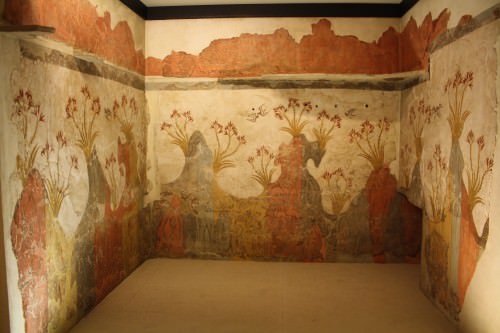
Lilies Fresco, Akrotiri
THE LILIES FRESCO
This fresco, also known as the Spring Fresco, comes from three walls of Room 2, a ground floor room from Building Delta, and depicts either papyrus or lilies growing amongst colourful volcanic rocks with swallows flying between the flowers. The lilies seem to be swaying in a gentle breeze and the flowers are depicted in various stages of growth from bud to full bloom. The fresco ignores the three plains of the walls to create a convincing surround effect which captures the vibrancy and regeneration of springtime. (National Archaeological Museum, Athens).
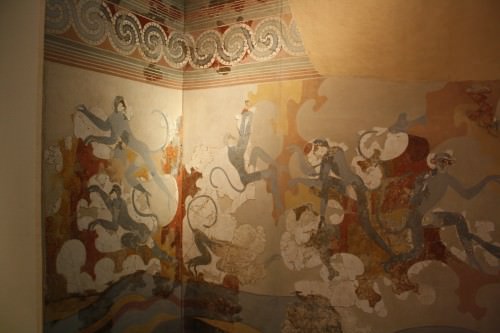
Monkey Fresco, Akrotiri
THE MONKEY FRESCO
This fresco depicting blue monkeys survives only in fragments and comes from Room B6. In the scene the monkeys are climbing rocks in an effort to escape the two dogs chasing them. Monkeys appear elsewhere in Theran and Minoan art, and they are often depicted as attendants to priestesses or near sacred altars. A fossilized monkey skull has been found on the island suggesting the possibility that they were present on Thera. (Museum of Prehistoric Thera, Santorini).
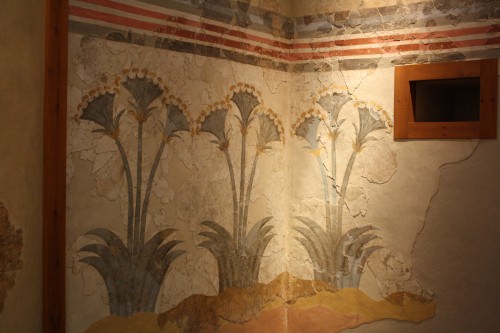
Papyrus Fresco, Akrotiri
THE PAPYRUS FRESCO
This fresco comes from the Room of the Ladies from the house of the same name. The papyrus flowers are shown in groups of three and cover three walls. They are not accurate in their depiction, perhaps deliberately so, but the iconography is Egyptian in style and, in any case, papyrus was not indigenous to Thera. Beneath the plants may be a river, a common association in both Minoan and Egyptian art. The discovery of ritual vessels within four sealed containers under the floor of the room suggests that it was used as a shrine. (Museum of Prehistoric Thera, Santorini).

Ship Procession Fresco, Akrotiri
THE SHIP FRESCO
This 6 metre fresco of a procession or escort of ships in miniature is from the south-west wall of Room 5 in the West House.Eight large ships and three smaller vessels, all powered by oarsmen, travel from one port to another with centre stage taken by the flagship of the fleet. The town on the right is more sophisticated (both in architecture and the inhabitants' clothes) and is identified by Marinatos as Akrotiri, whilst the flora and fauna of the town on the left identify it as Aegean, possibly another, more provincial town, on the island. In addition, the propulsion of the ships using oars suggests the two towns were not far apart. The scene may be a representation of a seasonal maritime festival or even a scene from a lost epic poem. The ships are decorated with flowers, butterflies, swallows, and symbols of nature which all suggest a religious festival as more likely.Dolphins very similar to those from Knossos leap between the ships and the buildings; flora and fauna in each port are drawn in great detail, as are the long robes of the ship passengers, which suggest they are of high social status and, once again, participating in an important religious festival. (National Archaeological Museum, Athens).
LICENSE:
Article based on information obtained from these sources:with permission from the Website Ancient History Encyclopedia
Content is available under License Creative Commons: Attribution-NonCommercial-ShareAlike 3.0 Unported. CC-BY-NC-SA License